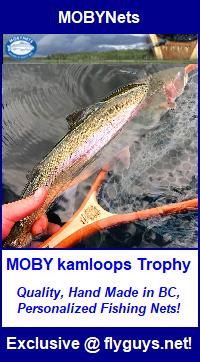
Perfect Fly Syndrome
… costing you fish & you don’t even know it!
Ah, the hard water season … a time of mixed emotions for most anglers. Fly fishing is on hold, so clearly that sucks, but on the other hand it creates a bit of time to get the gear tuned up and the fly box restocked. It is also the time of year where we generally offer our fly fishing & fly tying courses … can’t fly fish so might as well talk about it, right! 😉
After cycling through a few years of this routine I noticed a few common themes in the questions that students tend to focus on. There are always questions about the local lakes, and how to find the big fish within them. But at the end of the day the focus, the thing that most folks really seem to want to know about, is what specific fly pattern you used to catch that big fish! Now you might think a guy that has been developing fly patterns for most of his angling life, and has boxes (and a store) full of them, would agree that it’s all about the perfect fly pattern. Well, at one point in my fly fishing/fly tying journey you would have been correct. But truth be told, as the journey has progressed, it has slowly become clear that sometimes more can actually be less, and there just might be too much of a good thing.
Before we get much further let’s take a deeper look at the fly tying cycle. If I had to break it down I would describe the process something like this …
Stage 1 My tying sucks, my flies look terrible, but I’ve copied (to the best of my ability) a pattern that someone told me was a good one. I actually caught some fish on it, so I’m relatively happy and motivated to tie more of them. At this point my fly box is about 90% store bought flies with the remaining 10% consisting of two to three patterns that I tied myself. This is a relatively short stage for most folks. Once they experience some fishing and tying success, there is good motivation and reward to press on with it.
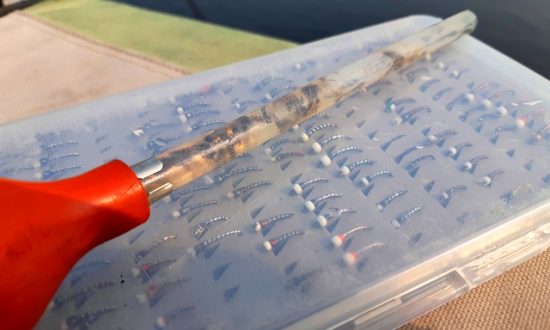 Stage 2 There’s not enough information out there to satisfy me. I scour through books / articles / websites / YouTube / IG / FB / etc, looking for more good patterns to add to my arsenal. The more I work at it, the better my flies look, the more fishing success I have with them, and the more desire I have to keep improving. During this stage it is likely that some of the flies that you were ecstatic about the year before have become unacceptable to you just one short year later. You are amazed that the fish even gave them a look last year! You write it off as fluke, and are happy that you know better now. This is also the time where you are focusing much more on the fine details of the insect that you are trying to imitate. You work through many prototypes with many different materials until you get the pattern just right … the perfect fish fooler!
Stage 2 There’s not enough information out there to satisfy me. I scour through books / articles / websites / YouTube / IG / FB / etc, looking for more good patterns to add to my arsenal. The more I work at it, the better my flies look, the more fishing success I have with them, and the more desire I have to keep improving. During this stage it is likely that some of the flies that you were ecstatic about the year before have become unacceptable to you just one short year later. You are amazed that the fish even gave them a look last year! You write it off as fluke, and are happy that you know better now. This is also the time where you are focusing much more on the fine details of the insect that you are trying to imitate. You work through many prototypes with many different materials until you get the pattern just right … the perfect fish fooler!
I’m not sure how long stage 2 lasts; it’s different for everyone I’d guess, but I am sure that many of the folks that reach it spend the remainder of their fly fishing life in it. I say this only because the topic of interest from the bulk of anglers that I encounter, whether in the courses, online, or just in general conversation, remains fairly consistent … for the most part the focus continues to be on the search for the perfect fly.
I’m also quite certain that the increase in fishing success that seems correlated with the improvement of fly patterns during this stage is only of marginal significance. In fact, the majority of angler improvement during this stage is much more likely the result of increased fishing knowledge as acquired from the increased amount of time (experience) spent on the water “testing” the improved patterns. I’m not sure why it is hard for anglers to recognize the positive impact that the increased fishing experience (time on the water) has had on their catch rate, perhaps it’s just a lack of confidence, but whatever the reason it seems to be the fly that continues to get the bulk of the credit!
To be clear, there is nothing wrong with the pursuit of the perfect fly. It is a very satisfying accomplishment that will likely up your catch rate to a degree. It’s only something that might become an issue if and when it clouds your approach, and actually starts to impart a negative effect/growth on your learning curve. Unfortunately, my encounters with younger anglers, along with my observations on the water, seem to indicate that this is indeed becoming the case. I feel that the newer “short attention span intraweb learning trend” is a good part of the reason why. There seems to be a very disproportionate amount of visual stimulation (a large number of fly patterns to look at) to knowledge being shared about said fly patterns. My fear (suspicion) is that the majority of any knowledge that is being provided is coming from folks whom have just recently crested Mount Hubris on the Dunning-Kruger confidence/competence spectrum (a little bit of knowledge can be a dangerous thing). There is, of course, some good information out there to be had for those that navigate through it all with caution … 😉
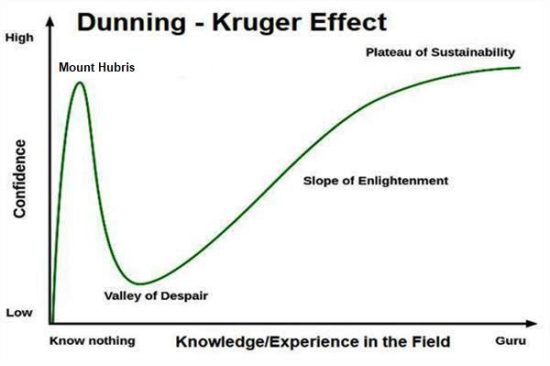
At any rate, as folks move through their own tying/fishing journey I’m sure that the situation would probably resolve itself over time. But again, for those that might not get there on their own, or would like to speed up the process, perhaps you can take something away from how it played out for me …
Stage 3 I’m not bored with fly tying but fishing is good and I don’t find myself “under gunned” on the water so, mostly unconsciously, I have stopped experimenting with new patterns to a large extent. As matter of fact, when I think about it now, the fishing has continued to improve despite the fact that I’ve just been using my old patterns. At this point I mostly tie flies when I get low on a certain pattern. Not long after that I started substituting low inventory patterns with similar ties and didn’t hit the bench until I was out of them as well. So, for example, if I ran out of chromie red ribs, I just used chromie black ribs … and I still caught fish. And then when I ran out of the white bead version, I just used the black bead version (even in murky water!) … and I still caught fish.
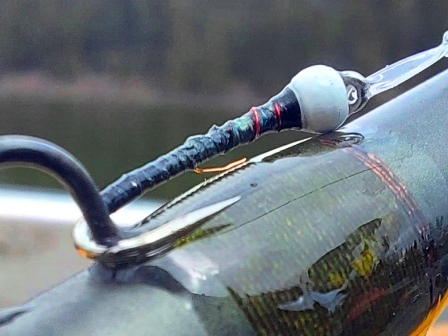
War Torn Zuke – Still Catching if in the Zone!
My focus has moved from “adding” patterns to “consolidating” patterns (ie. my brown/olive leech is now also my brown/olive dragon) and new ties have pretty much been regulated to patterns for insects that I cannot cover with my existing patterns. At the same time my “fly swap” frequency on the water has dropped significantly. When I’m struggling to get dialed in my mind now moves towards presentation changes as a solution as opposed to fly swaps … and I still caught fish!
So who cares? Tweaking flies is fun, and if the process is still marginally improving your catch rate, or even just satisfying the fly fishing itch, then what’s the problem? No problem at all. And in fact, one might argue that for many the process may even be a necessary component of the learning curve … to put in the work and come up with conclusions on one’s own, and within one’s own timeframe.
But if that’s not the case, and/or you are the type of person that would like to flatten the learning curve without having to go through the process yourself, then there are some good reasons to try and push over the stage 2 road bumps. First and foremost too much of a good thing means you are scouring over those jam packed fly boxes full of super similar versions of almost identical patterns instead of fishing . This mindset of swapping out one fly for another because you think it is required to get you into some fish may actually be costing you fish … and you likely don’t even know it!
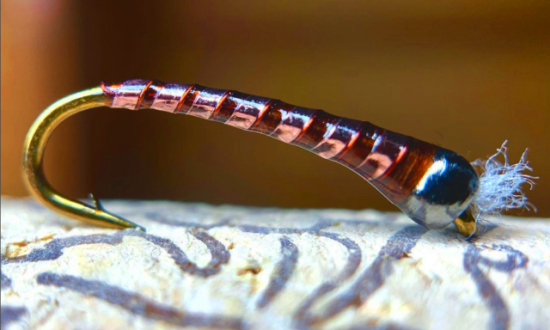
So with all of that out of the way let’s move onto the water and imagine a decent chironomid hatch where most anglers are catching fish fairly consistently but a few are struggling. Obviously those struggling could be doing so for various reasons, but if you look hard enough you will quickly pick out the folks struggling due to stage 2 perfect fly syndrome. These are the folks that will have their heads down in their fly box, lines out of the water swapping flies, for a longer period of time than the combined fish time of every fly they have tried so far. If you listen you will hear the evidence as the anglers shout out to those around them “what colour body are you using”, “what colour rib”, “what colour bead”, and so on.
 In this case, during a decent chironomid hatch where you can observe the size and colour of the hatching bugs, it is very unlikely that not using the absolute “perfect fly” is the reason for the lack of fishing success. In fact, during a good chironomid hatch when many anglers are having success it is very unlikely (virtually impossible) that they are all doing so with the exact same fly pattern. The same is true for non-hatch periods where proper presentation of a seasonally timed food source imitation should do the job. And if it’s not, then it’s much more likely because the reasonable representation that you are fishing is not being presented in the zone, or with the movement/retrieve desired by your prey. In both cases the angler’s fly is probably not the problem but “perfect fly syndrome” is prohibiting (blinding) the individual from that realization, and in turn from their ability to attempt a different approach/technique rather than just a different fly.
In this case, during a decent chironomid hatch where you can observe the size and colour of the hatching bugs, it is very unlikely that not using the absolute “perfect fly” is the reason for the lack of fishing success. In fact, during a good chironomid hatch when many anglers are having success it is very unlikely (virtually impossible) that they are all doing so with the exact same fly pattern. The same is true for non-hatch periods where proper presentation of a seasonally timed food source imitation should do the job. And if it’s not, then it’s much more likely because the reasonable representation that you are fishing is not being presented in the zone, or with the movement/retrieve desired by your prey. In both cases the angler’s fly is probably not the problem but “perfect fly syndrome” is prohibiting (blinding) the individual from that realization, and in turn from their ability to attempt a different approach/technique rather than just a different fly.
At this point it might be worthwhile to go into a bit more detail on what is meant by “reasonable” representation when referring to effective fly patterns. If we’re not striving for an exact representation then what exactly are we striving for? All physical attributes or just some of them? And if only some of them, which ones? And once we determine that, just how close of a match is necessary/critical?
In my experience there are just a few basic “building blocks” of replication that, when applied, will result in a pattern capable of achieving the vast majority of its potential with respect to catch rate/success, and every additional attribute after that, although not “unimportant” will typically offer only incremental advantages. Those basic building blocks are: Size, Profile (shape) and Tone (Dark vs Light / Shiny vs Dull), followed distantly by everything else: precise colour, segmentation (number of ribs), antennae, tails, gills, wing cases, breathers, eyeballs, etc. In general, the smaller the insect the less detail is required and any details above the basic building blocks should only be applied when you can do so without compromising/distorting proportions.

The other (often forgotten/omitted) piece is presentation. Do not underestimate movement (or lack of it) in your quest to “match the hatch”. How you move the imitation can be (often is) as or more important than an exact physical representation. Watch/learn how your target insect moves and try to imitate it. Generally stillwater insects move very slowly, but sometimes they dart, wiggle, dive and twitch. Understanding when to apply each will go a long way towards success on the water and is mainly achieved through observation and experimentation.
So if “Perfect Fly Syndrome” guy sounds like you, or like someone you know, the good news is that it’s an easy problem to overcome. And no, the solution is not less flies, perish the thought! Striving for the perfect replica is a worthy pursuit that can be very satisfying AND can absolutely up your marginal catch rate! But, although it’s not the direct problem, indirectly it can play a role in the mindset that “somewhere” within that vast field of fly patterns lays the Holy Grail that is needed to save the day. That mindset is the problem.
The solution is a better understanding of the game and a systematic approach to conquer it, starting with an understanding that your fishing skills/instincts have improved through the process and should be given the credit they deserve … hard to do perhaps, but essential in building confidence. Next is to take the required time (as much time as necessary) to locate fish, both where on the water body and then where in the water column, as fly pattern selection becomes irrelevant if not presented in the right location (where the fish are).
* check out our finding fish article here! 😉
Once fish have been located, work any of your reasonably suitable patterns (ones matching the size, profile & tone of the insect that you’re trying to imitate) until such time as you have determined the zone and presentation that elicits consistent strikes … which you will accomplish much faster without the constant swapping of almost identical fly patterns! Then, and only then, the hunt for the perfect fly that can bring the day to the next level can begin!
That’s all folks ……. 🙂
Like our stuff? Subscribe by ![]() Feed or
Feed or ![]() Email
Email .jpg)







